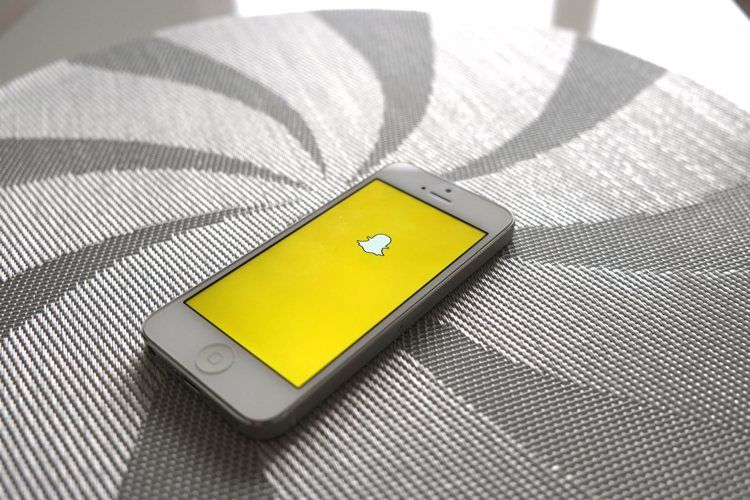This ephemeral social network triumphs among young people under 30 years of age, since the messages with photos and videos that are shared disappear from the mobile phones of its users shortly after being sent.

There are social networks that everyone knows, such as Facebook, Twitter or Instagram. But others are more enigmatic for certain sectors of the population, such as Snapchat . This application triumphs among the younger users , but is, in general, a complete unknown for the older people. In the United States, it is the third most used social network and is used by more than 40% of adolescents between 13 and 17 years old . In Spain there are not so many, but the figure grows little by little: from 12% of users in 2014, it has gone to more than 20% in 2015 . What does Snapchat have to make it so attractive to young people? This article analyzes this app and its features.
What is Snapchat?
Snapchat is an application for iPhone and Android that works in a similar way to an instant messaging app , such as WhatsApp or Telegram . The particularity of Snapchat is that, unlike those more traditional apps, it only allows you to share photos or videos made at the moment (not those already stored on the mobile), with the possibility of retouching them, adding texts, emoticons and even painting over them .
But the differences do not end here. Each image or video, known as a “snap”, has a limited existence (between 1 and 10 seconds) , established by the sender of the message. Thus, the receiver only has that time to be able to see the message: then it will disappear from the smartphone of the person who sent and received it and Snapchat will delete it from its servers .
The “snaps” are shared with a group of followers (as in Twitter, where what is shared reaches all those who follow the account), but it is also possible to send private messages to contacts, both text and photos -and here the images that are already saved in the phone do have a place. But as with publicly shared material, these private messages also disappear once the recipient has read them.
The only way for these messages to have life beyond those few seconds is to share them in a kind of timeline called My story (like the Twitter profile or the Facebook wall), where it is possible to publish photos and videos. But here they also have an expiration date : they will be deleted 24 hours after being published.
Whoever receives the message can take a screenshot of their mobile screen at the moment of viewing it. But the app warns of this if it happens.

What is Snapchat for?
Given its nature of immediacy, Snapchat triumphs as the fastest and most practical tool for broadcasting events, such as a party or a concert . It is also used by some companies or brands for their own broadcasts and even government bodies such as the White House, in search of a form of contact closer to the young people of today.
But you don’t have to be in a special celebration. The ephemeral nature of the content that is shared on Snapchat makes it ideal for capturing aspects of everyday life that are not important enough to be saved forever on the Internet: a selfie that did not turn out very well , a cake that has come out burned from the oven, a horrible pimple in the middle of the face … in general, snapshots that would be ashamed to publish online , because they remain there forever, but that it does not matter to share with trusted friends because they disappear after a few seconds.
One topic Snapchat rose to fame for was its use as a sexting tool . However, it was more the media that contributed to making a mountain out of a molehill, since less than 2% of the users of the application claimed to have used it for that purpose.

Why do young people like it so much?
Snapchat has been a hit with the youngest for a number of reasons. To begin with, it is one of the few social networks where they can escape the digital control of their parents . The older generations already have a Facebook account, have learned to use Twitter and have downloaded WhatsApp, but social networks with ephemeral content are something that escapes their understanding. And here children can say everything they think and feel without fear that their parents will read it or find it by searching on Google.
This expression also reaches its maximum level with the use of images and videos. The multimedia content is preferably in Snapchat above text messages, and it is precisely the most valued young, avid consumers of videos on YouTube, a platform increasingly used for more things.
Another positive point in the relationship of young people with Snapchat is its ephemeral and immediate nature . Kids today do not crave to store memories, as their parents do or their grandparents did. For them the valid thing is here and now, they like the immediacy to which the Internet has accustomed them. They value that freshness above perfection ; All those photos that are discarded for Instagram because they are not “perfect” have their place in Snapchat, where the most natural, more everyday, more authentic side of things is shown.
Finally, a point that must also be taken into account is privacy . It is becoming increasingly difficult to maintain a certain level of anonymity on the Internet , and young people are aware of this. Communication via Snapchat, with messages that are destroyed within a few seconds (or at most, within 24 hours of their publication), is a way to escape the controls of security agencies, governments or large Internet monopolies interested in data of its users.